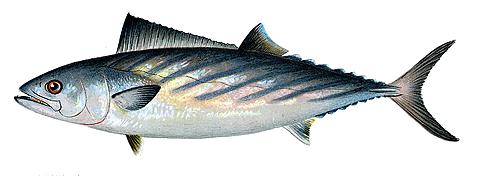Bonito


Classification[edit]
- Taxon - Sardini
- Authority - Jordan and Evermann, 1896
- Subdivision_ranks - Genera
- Subdivision:
- Cybiosarda (Whitley, 1935)
- Gymnosarda Gill, 1862
- Orcynopsis Gill, 1862
- Sarda (Cuvier, 1832)
Species[edit]
- Genus Sarda (Cuvier, 1832)
- Australian bonito, Sarda australis (Macleay, 1881)
- Sarda chiliensis (Cuvier, 1832)
- Striped bonito, Sarda orientalis (Temminck & Schlegel, 1844)
- Atlantic bonito, Sarda sarda (Bloch, 1793)
- Genus Cybiosarda (Whitley, 1935)
- Leaping bonito, C. elegans (Whitley, 1935)
- Genus Gymnosarda Gill, 1862
- Dogtooth tuna, G. unicolor (Rüppell, 1836)
- Genus Orcynopsis Gill, 1862
- Plain bonito, O. unicolor (Geoffroy Saint-Hilaire, 1817)
Food[edit]
Pacific and Atlantic bonito meat has a firm texture and a darkish color. The bonito has a moderate fat content. The meat of young or small bonito can be of lighter color, close to that of skipjack tuna, and is sometimes used as a cheaper substitute of skipjack, especially for canning purposes. Bonito may not be marketed as tuna in all countries, however.
Bonito that has been dried, fermented, and smoked, called katsuobushi, is a key ingredient in many Japanese soups.
The Atlantic bonito is also found in the Mediterranean and the Black Sea, where it is a popular food fish, eaten grilled, pickled (lakerda), or baked.
The bonito represents a tribe of ray-finned predatory fish, belonging to the larger Scombridae family. This is the same family that houses other notable fish species like mackerel, tuna, Spanish mackerel, and the butterfly kingfish. Known also as the Sardini tribe, the bonito group comprises eight distinct species spread across four genera, with three of the genera being monotypic, i.e., each having only a single species.
Etymology[edit]
The term "bonito" finds its roots in both the Spanish and Portuguese languages, translating to "pretty" in English. However, the connection between the fish's name and this adjective remains ambiguous. Additionally, the relationship between the Arabic term "bainīth" and its Portuguese/Spanish counterpart is equally unclear, leaving the etymology of "bonito" open to interpretation and further research.
Physical Characteristics[edit]
Bonitos are medium-sized fish, known for their streamlined bodies that aid in swift movement through water. They possess distinct patterns on their back, which typically comprise a series of horizontal stripes, zigzags, or wave-like patterns.
Distribution and Habitat[edit]
Bonitos are typically found in warm oceans worldwide. They often dwell in both open and coastal waters, occasionally venturing into more temperate or even cold waters. Being migratory, they are known to travel long distances in search of food or during breeding seasons.
Diet[edit]
Predatory by nature, bonitos primarily feed on smaller fish, crustaceans, and cephalopods. Their keen eyesight and rapid speed make them formidable hunters in their habitats.
Relation to Other Fish[edit]
While bonitos bear a resemblance to other members of the Scombridae family, especially tunas, they can be distinguished by their sharp teeth, distinct patterns, and slender bodies.
Commercial Significance[edit]
Bonitos are widely fished for their meat, which is considered a delicacy in many cultures. They are either consumed fresh or preserved in the form of dried flakes, which are particularly popular in East Asian cuisines.
Conservation Status[edit]
Due to their commercial value, some species of bonito face threats from overfishing. It's essential to monitor and manage fishing practices to ensure the sustainability of the bonito populations.
See also[edit]
References[edit]
- O'Toole, B. (2002). The Complete Guide to Saltwater Fish. London: Collins & Brown.
- Hayashi, K. (1999). Bonito and its Role in Japanese Cuisine. Tokyo: Kairen Press.
- Scombridae. (n.d.). In Marine Species Identification Portal.
Ad. Transform your life with W8MD's Budget GLP-1 injections from $75


W8MD offers a medical weight loss program to lose weight in Philadelphia. Our physician-supervised medical weight loss provides:
- Weight loss injections in NYC (generic and brand names):
- Zepbound / Mounjaro, Wegovy / Ozempic, Saxenda
- Most insurances accepted or discounted self-pay rates. We will obtain insurance prior authorizations if needed.
- Generic GLP1 weight loss injections from $75 for the starting dose.
- Also offer prescription weight loss medications including Phentermine, Qsymia, Diethylpropion, Contrave etc.
NYC weight loss doctor appointmentsNYC weight loss doctor appointments
Start your NYC weight loss journey today at our NYC medical weight loss and Philadelphia medical weight loss clinics.
- Call 718-946-5500 to lose weight in NYC or for medical weight loss in Philadelphia 215-676-2334.
- Tags:NYC medical weight loss, Philadelphia lose weight Zepbound NYC, Budget GLP1 weight loss injections, Wegovy Philadelphia, Wegovy NYC, Philadelphia medical weight loss, Brookly weight loss and Wegovy NYC
|
WikiMD's Wellness Encyclopedia |
| Let Food Be Thy Medicine Medicine Thy Food - Hippocrates |
Medical Disclaimer: WikiMD is not a substitute for professional medical advice. The information on WikiMD is provided as an information resource only, may be incorrect, outdated or misleading, and is not to be used or relied on for any diagnostic or treatment purposes. Please consult your health care provider before making any healthcare decisions or for guidance about a specific medical condition. WikiMD expressly disclaims responsibility, and shall have no liability, for any damages, loss, injury, or liability whatsoever suffered as a result of your reliance on the information contained in this site. By visiting this site you agree to the foregoing terms and conditions, which may from time to time be changed or supplemented by WikiMD. If you do not agree to the foregoing terms and conditions, you should not enter or use this site. See full disclaimer.
Credits:Most images are courtesy of Wikimedia commons, and templates, categories Wikipedia, licensed under CC BY SA or similar.
Translate this page: - East Asian
中文,
日本,
한국어,
South Asian
हिन्दी,
தமிழ்,
తెలుగు,
Urdu,
ಕನ್ನಡ,
Southeast Asian
Indonesian,
Vietnamese,
Thai,
မြန်မာဘာသာ,
বাংলা
European
español,
Deutsch,
français,
Greek,
português do Brasil,
polski,
română,
русский,
Nederlands,
norsk,
svenska,
suomi,
Italian
Middle Eastern & African
عربى,
Turkish,
Persian,
Hebrew,
Afrikaans,
isiZulu,
Kiswahili,
Other
Bulgarian,
Hungarian,
Czech,
Swedish,
മലയാളം,
मराठी,
ਪੰਜਾਬੀ,
ગુજરાતી,
Portuguese,
Ukrainian
